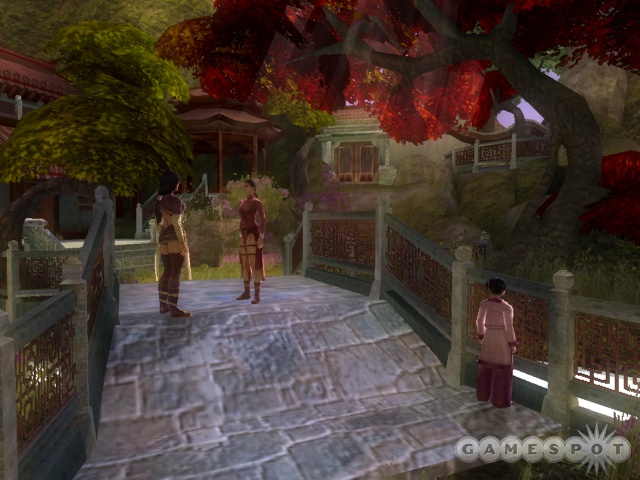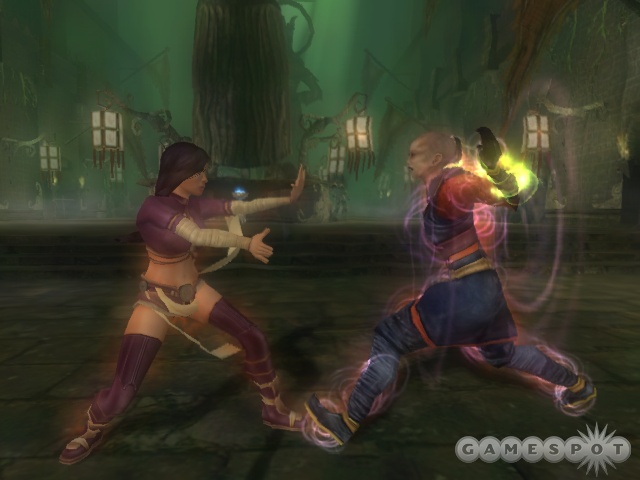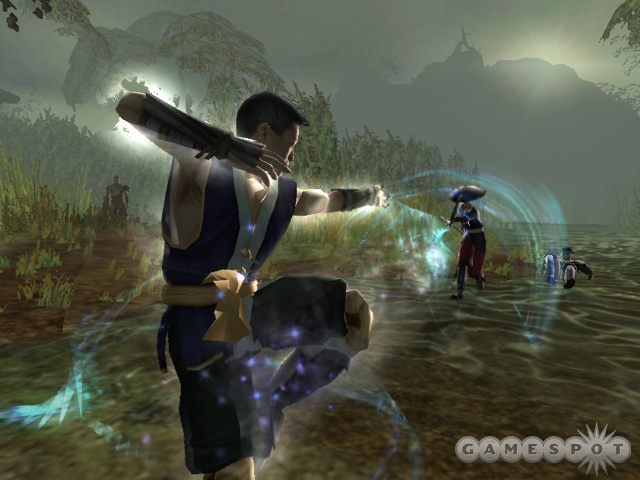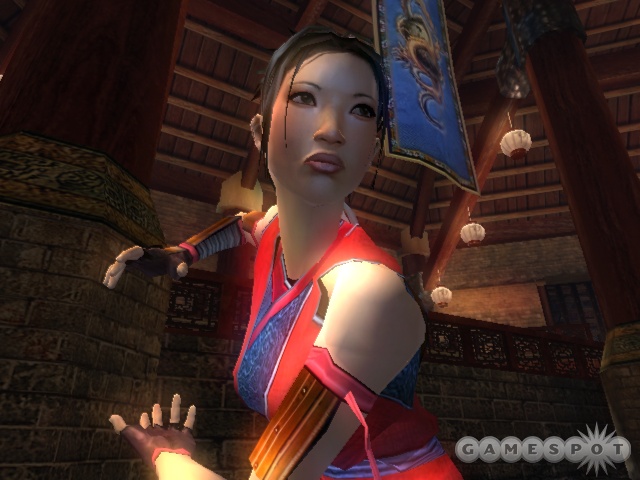Jade Empire Updated Hands-On
We play through the early stages of BioWare's upcoming kung fu role-playing game.
Currently scheduled for release in March 2005, Jade Empire is an action role-playing game in which you'll assume the role of a martial arts expert who must combat evil in the titular Jade Empire, a territory loosely based on those found in several periods of Chinese history and one of many that makes up the high-fantasy world created specifically for the game by developer BioWare. During a recent visit to BioWare's Edmonton office, we had the opportunity to play through the early stages with a couple of different characters and are pleased to report that the developer looks certain to maintain its track record of making every game better than its last.

If you've played BioWare's last game, the multiple-award-winning Star Wars: Knights of the Old Republic, you'll actually have a reasonably good idea of what you can expect from Jade Empire, at least in terms of its structure. As in KOTOR, your character in Jade Empire will evolve as you progress through the game, both as a result of actions that sway your alignment toward good or evil and through experience points that can be applied toward improving certain attributes and skills. You'll also have the opportunity to add up to 12 non-player characters to your party as you play, and each of them has his or her own combat style, storyline, and alternate endings. Jade Empire isn't set in the Star Wars universe, of course, but the game definitely owes a lot to numerous martial arts movies. Fist of Legend and Five Venoms, for example, have been cited as influences by members of the development team, along with the classic 14th century Chinese novel Outlaws of the Marsh.
Before we actually got hands-on with Jade Empire, we were treated to a live demonstration that showed off three previously unseen areas from the game, as well as a number of different enemies. The first area was an ancient neighborhood known as The Necropolis, which was inhabited by lost spirits. These lost spirits were translucent enemies that, because of their immunity to all weapon-based attacks, were defeated by employing a combination of ice attacks (temporarily freezing them) and "thousand cuts" punches. The second locale was a forest that, although it had evidently once been an area of great beauty, was inhabited by ghosts and basically didn't look like the kind of place you'd want to go to for a picnic. While in the forest, the BioWare representative's character, Lu the Prodigy (more about player characters later), was accompanied by a previously unseen and particularly intriguing follower named Wildflower, who looked as harmless as her name suggested because she was a young girl with pigtails. However, Wildflower's body played host to two demons, one good and one evil. We got to see Wildflower transform into one of these two demons once combat got under way, and we were also shown one of the ways in which you'll be able to use the environment to your advantage. In this case, ghost enemies, who dislike light and heat, were lured toward a flaming altar where they spontaneously combusted. The third level we were afforded a glimpse of was taken from much later in the game, and it was set place in a cave system underneath the city of Dirge. The caves were never so dark that it was difficult to see what was going on, which was good, because the caves were frequented by "horse demons" that had skeletal heads and fires burning on their backs. Predictably, the demons were immune to flame attacks, but the overall challenge they posed was relatively insignificant compared to the boss encounter with the "Minion of Suffering" that concluded the demonstration (for which the BioWare player eventually resorted to the easiest of the three difficulty settings).

Once we got our hands on the game, our first task was to select one of five available characters to play. The characters at our disposal included: Wu the Lotus Blossom, a balanced female fighter who studies magic and weapon techniques equally; Furious Ming, an incredibly fast, agile, and brash fighter who specializes in unarmed combat; Tiger Shen, an unbelievably strong, young but slightly ponderous fighter whose barbarian-like appearance belies his charismatic and gentle nature; Scholar Ling, a female magic user; and Lu the Prodigy, a young student who is remarkably adept at learning new skills, whether they're fighting styles, musical instruments, or languages. For our first play, we chose Lu the Prodigy. And after checking out the limited pregame customization options that let you redistribute health, chi, and focus attribute points, as well as opt for a different pair of fighting styles to start the game with, we found ourselves engaged in a conversation with another student at the Two Rivers school. Since our character was the top student at the school (this is true no matter which character you choose to play as), this other student was hoping for an opportunity to spar with us. In the absence of a tutorial (the final game will have one, but it hasn't been implemented yet), the brief sparring session that followed the conversation gave us a chance to familiarize ourselves with the game's controls, and it also let us try out the rock-paper-scissors combat system. The combat has a little more depth to it than rock-paper-scissors, of course, but no matter which of Jade Empire's 30-plus fighting styles you choose (you can have four mapped to the directional pad simultaneously, thus allowing you to switch between them on the fly), you'll find that strong attacks are unblockable. However, they do take a while to charge up. Blocks work against faster light attacks, and light attacks are very effective against characters that are in the process of charging up strong attacks. As you progress through the game, you'll learn that different fighting styles are more effective against certain enemies, consequently making combat much more tactical. Although in the early stages that we played through, this was a rare occurrence.
Old Tongue
At the end of our sparring session, our opponent told us that Master Li, the head of the school, wished to see us in his quarters. So, after taking a brief tour of the school grounds and engaging in short conversations with some of the other students, we met with him and had the first real opportunity to put our character's conversation skills to the test. Conversations were handled in exactly the same way as those in KOTOR, so the consistently excellent voice acting was always accompanied by text subtitles, and whenever it was our turn to speak, we were presented with two to six choices of phrases, sentences, or questions. Though many of the choices at this stage of the game were simply opportunities for us to ask questions, there were instances where we clearly chose to say something that would be perceived by other characters as gracious, arrogant, or something in between, which resulted in a slight shift in our character's alignment. In conjunction with the standing of your character's charm, intuition, and intimidation skills (which are determined by your body, mind, and spirit attributes), your alignment will play a part in determining how other characters interact with you, as well as present options for when it's your turn to speak. At this point, it's also worth mentioning that the text that appears during conversations is sometimes necessary for understanding what characters are saying to you, unless, of course, you happen to be fluent in the fictitious language of Tho Fan (Old Tongue), which BioWare had a linguist create specifically for the game.

The combat in Jade Empire is definitely easy to pick up, but we certainly wouldn't describe it as simplistic. It didn't take us very long to augment our two starting styles with a further two, so we soon found ourselves switching between them quite regularly. Sometimes we did so just because we could, while at other times we did so because certain styles were definitely proving more effective than others. The styles we started the game with, incidentally, were an unarmed technique named legendary strike and heavenly wave, which allowed us to temporarily slow down opponents with magical ranged attacks. You'll also start with a useful focus skill that, for as long as your focus meter isn't empty, allows you to play the game in a Matrix-style bullet time, which slows down your enemies' movements quite dramatically while letting you continue to move at your regular speed. The first additional fighting style that we learned was weapon-based, and it became available to us when the story required us to choose one of two weapons with which to defend the small town in which the early stages of the game are based. The weapons available to us were a sword (which allowed us to dish out a lot of damage at close range) and a staff (which could be used to attack enemies from a relatively safe distance, in addition to letting us prod enemies that were lying on the ground). The second technique we learned was the leaping tiger style, which had us lunging at enemies and swiping at them using large "claws" worn on the hands. The leaping tiger style was definitely our favorite technique, and it was made all the more satisfying by the fact that we automatically learned it when we defeated an enemy who was using the technique. We were told that BioWare's main goal when creating the new combat system was to make it more fluid and reflex-based than that of KOTOR, but it was also designed to require players to think about different tactics and styles. Based on our time with the game, we're pleased to report that the team has done an excellent job. And while we found that switching between styles and targets was easy enough on the fly, some of you might be pleased to hear that you'll also be able to do both of these things while the game is paused.
The largest battle that we found ourselves in saw us pitted against five or six enemies simultaneously, and they weren't shy about coming at us in numbers, which usually consisted of two or three attackers at a time. Thankfully, we were accompanied by the first of the game's "follower" characters, a strong and spiritual fighter named Dawn Star, who, unless we were horribly misinterpreting all the signals, could well turn out to be a love interest as the story progresses. We didn't have any control over Dawn's actions at any point during the game, but she seemed to be more than capable of looking after herself and was certainly a help rather than a hindrance. Like all the non-player characters we encountered, Dawn Star was believable in every way thanks to some well-written and well-voiced dialogue, decent facial animations and lip-synching, and excellent combat animations, all of which were created using motion-capture techniques. Along with Dawn Star, the characters that made the biggest impressions on us during the demo included the elderly but awesomely powerful Master Li and Gao, the requisite arrogant rival/bully character whose behind we very satisfyingly kicked in front of the entire school at one point.

To reveal much more about the early stages of Jade Empire's story would be to risk spoiling parts of it, so we will tell you that the demo we played concluded with a boss battle of sorts. We'll also tell you that our reward for defeating the boss, who was far more powerful than any of the enemies we'd faced up to that point, was a choice of two magic styles, one ice-based and one fire-based. As you've probably gathered, we enjoyed our time with Jade Empire a great deal, and while the version we played featured an excessive number of autosaves, we were assured that these won't be nearly as frequent in the finished game. The only other remotely negative thing we can think of to say at this point is that our choice of character, and even the choices we made during conversations and such, actually had very little bearing on our progression through the demo. We played both as a very gracious Lu the Prodigy and as a very arrogant Tiger Shen, and the two experiences were remarkably similar, though that's hardly a criticism given the highly entertaining experiences offered by each character and each character's game path. It's also worth mentioning that an hour isn't nearly long enough to shape a character that's either loved or hated by everybody he or she encounters.
BioWare, which has been known to underestimate the length of time it takes for players to complete its games, reckons that Jade Empire should take a minimum of 25 to 35 hours to play through on the regular difficulty setting. We're also told that the critical path through the game, which is represented by the stuff that's mandatory rather than optional, accounts for approximately 60 percent of the overall content. So there you have it. Jade Empire looks to be coming along quite well thus far, so we can only wait for a March 2005 that won't come quickly enough.
Got a news tip or want to contact us directly? Email news@gamespot.com
Join the conversation